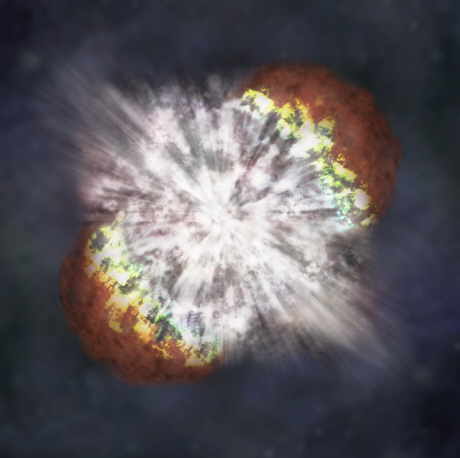 |
|
Supernova Illustration. Credit: NASA/CXC/M.Weiss. |
THE UNWRITTEN CHAPTER
 |
|
Supernova Illustration. Credit: NASA/CXC/M.Weiss. |
This is included to address the belief of some people that the VM may be of importance beyond its factual existence as a book. I have found no evidence of it being anything other than an extraordinary record of rare astronomical events, but the subject of supernovae can be extended beyond the actual manuscript and into a contemporary setting.
Supernova
The supernovas of the past occurred in very different societies to now. In China the order of the sky reflected order on earth, and it was the responsibility of the Emperor to maintain this by his correct actions but also for others to maintain their allotted path in life. In Europe the scientific and spiritual world were not separated as now and science, superstition and religion all impacted on the understanding of the astronomical realm. Now (particularly in the West) we have separation of mind, body and spirit, to have any impact a supernova would have to overcome this and our modern outlook on life, in short it would have to be spectacular and stand out from among the many wonders of modern society. Venus is approximately -4 magnitude and the full moon -12 to -13 magnitude, yet these bodies are ignored on a daily basis and do not capture the imagination of people, at least in Western society . A supernova so bright that it outshines the full moon might just about be noticed - but one that shines like a second sun during the day also would fare better. To be experienced by the most people it would have to be in the Southern latitude or equatorial at the very most. The Northern latitude would not need to observe it directly, due to our comprehensive media coverage we would know about it in great detail and this is probably the way most people would be exposed to its existence.
In the past celestial events, particularly spectacular or rare ones, were associated with events on earth and given almost godlike power to influence events on earth. Some were thought to be fortunate but mostly they were signs of impending misfortune and doom. One may think that that would no longer be the case, that it would be seen from a purely scientific point of view as a natural wonder but that is not likely to be the case. An event of that magnitude would still be seen by some as a sign of impending doom, even the end of the world, but others would see it as a sign of hope. It would not, even if very near, destroy the world, as some contemplated back in 1604. Even the nearest supernova (according to scientists) would only cause disruption to the upper atmosphere, satellites etc. with some damage from long-term exposure to blue-enhanced light. Like the supernovas of the past it would come, go, and leave us astounded and wondering. The brightest star seen in the history of man, that lights the day as well as the night, known throughout the world, may just make it into the unwritten chapter of the Voynich Manuscript.
Summary of SN 1054 and SN 1572
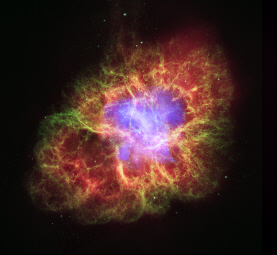 |
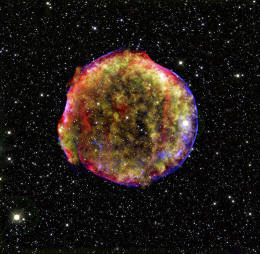 |
| Crab Nebula. Credit: X-ray: NASA/CXC/ASU/J.Hester et al.; Optical: NASA/ESA/ASU/J.Hester & A.Loll; Infrared: NASA/JPL-Caltech/Univ. Minn./R.Gehrz | Tycho's supernova remnant. Credit: X-ray: NASA/CXC/SAO, Infrared: NASA/JPL-Caltech; Optical: MPIA, Calar Alto, O.Krause et al. |
1). MAGNITUDE:
SN 1054 magnitude -6.
SN 1572 magnitude -4.
2). LOCATION:
SN 1054 visible in constellation Taurus.
SN 1572 visible in constellation Cassiopea.
3). VISIBILITY:
SN 1054 visible in the day for 23 days, in total for 653 days.
SN 1572 visible in the day for aprox. 2 weeks, in total for aprox. 16 months.
4). EFFECTS ON EARTH:
SN 1054 - none known.
SN 1572 - none known.
5). PERCEPTION:
SN 1054 - in China any change in the sky usually bad, it represented disorder on earth and unfortunate for the Emperor who was held responsible. In Europe possibly associated with the East-West Schism, explaining the lack of records for it in Europe.
SN 1572 - Tycho saw it as a bad omen.
6). ASSOCIATED COMET:
SN 1054 possibly accompanied by a low intensity comet.
SN 1572 followed by and connection attributed to the “great comet” of 1577.
7). ASSOCIATION WITH EVENTS:
SN 1054 associated with death of Emperor Xingzhong in 1054 AD and possibly with the East-West Schism of 1054.
SN 1572 Tycho associated the supernova and especially the “great comet” that followed some years later with forthcoming disaster and predicted, “a great Catastrophe and universall change throughout the chiefe Nations of the Earth” (Learned:Tico Brahć, his astronomicall coniectur of the new and much admired [star] which appered in the year 1572. C4 verso, Linda Hall Library).
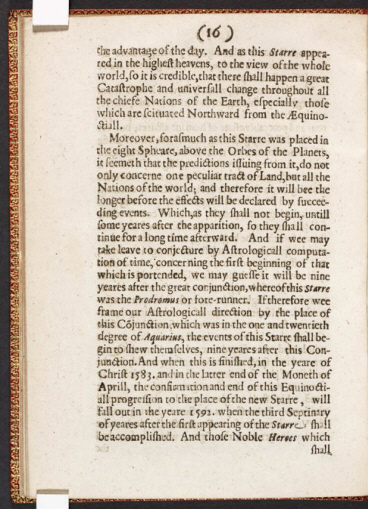 |
|
Learned: Tico Brahć, his astronomicall coniectur of the new and much admired [star] which appered in the year 1572. p16leafc4verso. Credit: Linda Hall Library of Science, Engineering & Technology |
Full details of Tycho’s astronomical prediction on the new star can be found here in a 1632 English translation at the Linda Hall Library:
http://lhldigital.lindahall.org/u?/astro_early,231
Summary of Projected Future Supernova
1). MAGNITUDE:
Far greater than -6, brightest naked eye supernova in history.
2). LOCATION:
Directly visible in the Southern hemisphere/equatorial, Northern hemisphere via media only. Exact location in the sky unknown beforehand.
3). VISIBILITY:
Visible in the day like a second sun and at night provides more light than the full moon.
4). EFFECTS ON EARTH:
None directly on earth? Some in the upper atmosphere of earth affecting satellites and space stations (according to some scientists regarding even the nearest possible supernova) and dangerous long-term effect of exposure to blue-enhanced light possible.
However...according to other scientists extreme effects from ionizing radiation - electromagnetic radiation and ionized cosmic ray particles from a near explosion (nearer than approx. 30 light years) could not be ruled out. This could could cause damage to the ozone layer, DNA and modern technology and its effects could disrupt photosynthesis and therefore the food chain supply. Gamma radiation and x-rays could be a particular concern.
5). PERCEPTION:
A warning sign, doom, fear, but mostly a sign of hope assuming there are no catastrophic effects from a very near explosion.
6). ASSOCIATED COMET:
May be accompanied or soon followed by a comet of note, even earth grazing, or an asteroid and THIS rather than the supernova its self could be an issue.
7). ASSOCIATION WITH EVENTS:
Associated with events of importance by some people.
My Personal Projection
Is the time now for the unwritten chapter to unfold? The nature of supernovae is that they appear without warning, so no time projection, "ifs" or "whens" are appropriate concerning an actual event. But for the record, I see this area as being such a candidate, and events that occur around its appearance to be of significance as would be its actual celestial location:
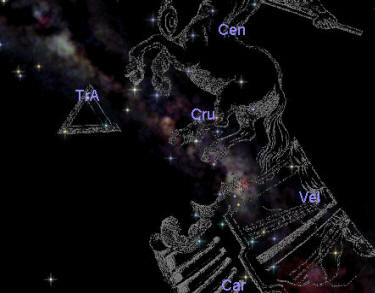 |
| Credit: Redshift 6. Star map showing the area around Centaurus. |
Link to a celestial globe at the National Maritime Museum (NMM) showing this region of the sky:
http://www.nmm.ac.uk/upload/img_400/D5295.jpg
Closing Thoughts
A theory can only comment on what is present, and hypothesise on what is not present and there are pages missing from the Voynich Manuscript which could drastically alter the conclusions of this theory. The later missing pages could contain details of Kepler’s supernova and the earlier ones of SN 1006 (and also on f r1) and Tycho’s supernova in Cassiopeia could be shared with a possible earlier supernova in 1181 AD. If other supernovae were mentioned then it would become less about a comparison of the greatest observers of the sky before the telescope (Chinese and Tycho Brahe) and more about supernovae and astronomy in general. Given the era that the Voynich Manuscript was written it is most likely that the botanical sections are deeply intertwined with the rest of the manuscript subject matter but this has not been addressed here.
Tycho’s motto “suspiciendo despicio” (De Mundi atherei recentioribus Phoenomenus Progymnasmatum ,1588) sums up the relation of the sky and earth in the past. Life, wisdom and people were not compartmentalised into strict areas of separation, people were seen holistically and the body, mind, and spirit were viewed holistically. We would consider it superstitious to suggest the stars can affect what happens on earth in some predestined manner, but maybe by separating the world and human society so completely into compartments we have lost more than we have gained. To the people of the 17th century the advancements of optics and the telescope that led to the understanding of the solar system, the microscope opened up an unseen world of understanding of life and structures and brought an understanding of infection and the building blocks of life. Now we understand down to the genetic level and even attempt to recreate life, our telescopes travel to the distant places of space, yet, now as then, science however advanced will not solve world problems, we still have starvation, wars and displacement. We overlook the human spirit and forget that changing the human heart is the real mystery, and for all our understanding of the universe all that science alone reassures us of is that we are alone and without purpose. It is time to see life with spirit and compassion as well as intellect, and see the big picture.
One further thought to be noted is that SN 1054 may have been deliberately withheld or removed from European records because of it’s correlation to the East-West Schism of 1054 AD. The supernova would have been visible very low on the horizon in Europe and for less time than in China. European observations were not as thorough as the Chinese until the time of Tycho Brahe, but it would not have been totally unobservable given good weather conditions. But that, as they say, is another story and another branch in the search for the solution to the Voynich Manuscript
Copyright © 2010 P. Han